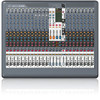Behringer XENYX XL2400 Manual - Page 10
Stereo inputs, Main mix outputs, Subgroup connectors, CD/tape connectors, INSERT, DIRECT OUT - used for recording
 |
View all Behringer XENYX XL2400 manuals
Add to My Manuals
Save this manual to your list of manuals |
Page 10 highlights
10 XENYX XL3200/XL2400/XL1600 User Manual INSERT The INS(ert) connector (¼" stereo jack connector) is used to connect to external signal processors. Here you can hook up a compressor, noise gate or equalizer to process the signal of a single channel. The insert jack is placed before the fader, EQ and aux send. Please use an insert cable to connect to the insert point. INSERT Like the channel inserts, the INS(ert) connectors can be used to hook up a dynamics processor or equalizer for further processing of the mix signal on OUT A. 4.5 Subgroup connectors DIRECT OUT This ¼" mono jack connector is a direct output which taps the signal after the channel fader to route it to a multi-track recorder, for example. By modifying the circuit board in the unit, the signal can also be tapped pre-fader (see chapter 6). 4.3 Stereo inputs GROUP OUT 1 - 4 These four GROUP OUTS 1 - 4 carry the signals of the individual subgroups. For multi-tracking connect the outputs to the inputs of a multi-track recorder. LINE L (MONO), LINE R The stereo channels consist of two line inputs (¼" jacks), one for the left and one for the right channel. The inputs are balanced (TRS connectors), but it is also possible to connect to unbalanced plugs (TS connectors). These channels can also be used as mono channels by connecting to the jack labeled "L" (left). MIC The stereo channels also consist of XLR inputs for connecting to microphones DI boxes and multicores. +48 V This is the phantom power for operating capacitor microphones along with the control LED located next to the switch and in the Trim section of the stereo channels. INSERT Each subgroup has an insert jack which is labeled INS. Here you can connect to a noise gate, compressor or equalizer to process the subgroup signal as a whole. For example, route your background vocalists to one subgroup bus and then use a compressor to bring the vocals closer together. This makes it sound more like a choir rather than a group of individual soloists. The insert point is placed before the group fader, allowing the dynamics processors (noise gate, compressor, etc.) to be optimally used and not affected by changes in volume level of the group fader. Please use an insert cable to connect to the insert point. SPEAKERS The SPEAKERS outputs provide the same signal as the headphone outputs. Use these outputs to hook up monitor speakers. This is helpful when the mixing console is not located close the performance but in a separate room, such as a TV control room. It is also possible to hook up a stage monitor, ideally one identical to the monitors being used on stage, to listen in on the sound as perceived from the stage monitors. 4.6 CD/tape connectors 4.4 Main mix outputs IN The CD/TAPE input connectors are used to hook up CD players, tape decks or other line-level sources. OUT A The OUT A outputs are balanced XLR connectors with a nominal operating level of +4 dBu and provide the main mix signal. OUT The CD/TAPE output connectors provide the stereo main mix signal to a tape deck or DAT recorder to record your mix. The signal is taken pre-fader so that it will not be influenced by the fader positions. OUT B The OUT B outputs provide the MAIN B signal the volume level of which can be controlled.















